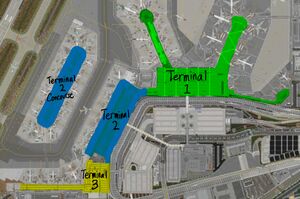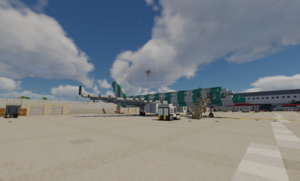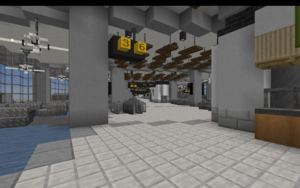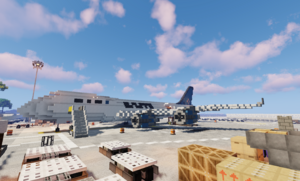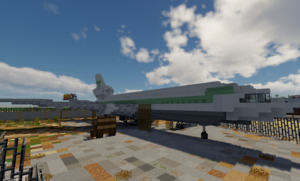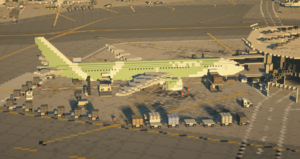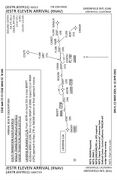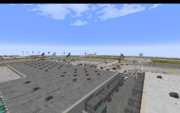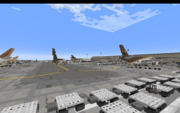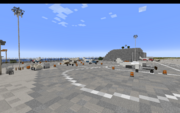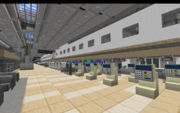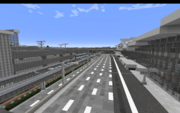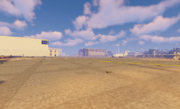Greenfield International Airport
Greenfield International Airport | |||||||||||||||||||
|---|---|---|---|---|---|---|---|---|---|---|---|---|---|---|---|---|---|---|---|
 | |||||||||||||||||||
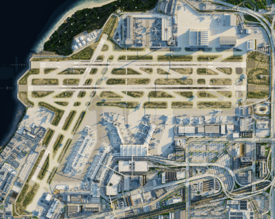 Aerial shot of Greenfield International Airport | |||||||||||||||||||
| |||||||||||||||||||
| Summary | |||||||||||||||||||
| Airport type | Public | ||||||||||||||||||
| Serves | Greenfield Metropolitan Area | ||||||||||||||||||
| Location | Lannex, Greenfield, U.S. | ||||||||||||||||||
| Opened | 0.5.4 | ||||||||||||||||||
| Hub for | |||||||||||||||||||
| Focus city for | |||||||||||||||||||
| Elevation | 31 ft / 9 m | ||||||||||||||||||
| Coordinates | 3600, -1900 | ||||||||||||||||||
| Map | |||||||||||||||||||
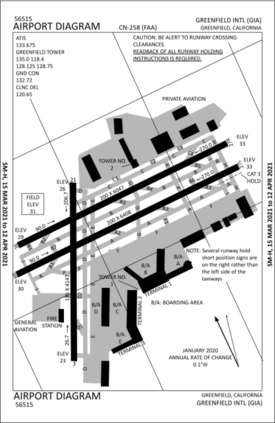 GIA Airport Diagram | |||||||||||||||||||
| Runways | |||||||||||||||||||
| |||||||||||||||||||
Greenfield International Airport (IATA: GIA, ICAO: KGIA, FAA LID: GIA), typically referred to as Greenfield Airport, is an international airport located on the northeast side of Greenfield, California. Operated by the Greenfield Department of Aviation, and covering over 4 kilometers of land, GIA has non-stop flights to over 130 destinations in North America, South America, Europe, Africa, Asia, and Oceania as of 2022.
GIA began as an airfield for manufacturing C-54 military transports during World War II. As one of the first airports developed after the war, GIA's innovative design pioneered concepts such as concourses, direct highway access to the terminal, jet bridges, and underground refueling systems. GIA became famous during the jet age, holding the distinction as one of the world's top fifty busiest airports from 1963 to 1998, reaching 27th place in 1994. In 2019 it was the world's ninety-sixth-busiest airport, serving 20 million passengers.
GIA also serves as the primary western hub for SkyLiners Airlines, and is the companies second largest hub.
History
Establishment
Starting in 1923,, the California National Guard used the present airport site (known then as the Lannex lowlands) as a training airfield. The site was then dedicated as the "Greenfield Municipal Airport" by then Mayor in 1926, but it had no proper terminal building until 1939, many airlines choosing to utilize Los Angeles, San Francisco or San Diego instead. Once Greenfield's terminal as completed, multiple airlines including Skyliners and Unified began service here.
As its terminal was completed, two runways, 3/21 and 09/27, were built to meet the demand for land-based planes making operations at Greenfield.
On August 17th, 1942 the airports weather station became the official point for Greenfield weather observations and records by the National Weather Service.
World War II use
During World War II the United States Navy used the airport as a training facility as well as a construction site for the manufacturing of the Douglas C-54 Skymaster military transports. A major defense contractor and contributor to World War II transport production, C54 Aircrafts, later known as Derksair, had their headquarters on the border of the Municipal field, and built many of their military aircraft theere. Derksair used the airport for test and delivery flights from 1935 to 1952 when their main facility burned to the ground.
Because of its location next to the Pacific ocean, it was believed that the airport could be a target for Japanese retaliation especially after Pearl Harbor. Special care was taken to protect the construction facilities including building a fake neighborhood on the roof of the warehouse. This town known as Little Lannex was made of wood and fabric and hid the massive construction hangar from the sky. However Greenfield never saw any combat during the war, and in a cruel turn of fate the supplies on the roof are believed to have caused the fire that burned down the facility and caused Derksair to go out of business at the end of the war. The vacant space left by the hangar was used in later years to develop jet age terminals.
Passenger service and growth
Greenfield Municipal became Greenfield International in 1946, when Nordair began direct flights here from Vancouver with their newly delivered Douglas DC-4s. The original terminal 1 did not have jet bridges and thus many felt a new terminal was needed to bring Greenfield into the jet age. A new terminal opened in 1955 which is currently the oldest existing terminal at the airport now called Terminal 3.
Terminal 1 and 3 modernization was completed in 1971, Terminal 2 opened in 1974 while the concourse opened in 1977. The $500 million expansion was one of the largest single building projects ever taken on by the city. In 2015 the airport finished construction on their brand new international terminal at the location of the old terminal 1. Many preservationists where angry at the destruction of the historic terminal building, but there was realistically no way the facility could have been outfitted for the modern needs of passengers and airlines. The new terminal 1 serves as the international terminal and holds the US customs. During this time a baggage system modernization occurred across the entire airport.
In the 1980s GIA hosted hubs for Skyliners and Vision Airlines. The Airline Deregulation Act of 1978 allowed regional carrier Altis (later renamed Speedfly Airlines) to create a small hub at GIA. Skyliners became the dominant carrier at GIA in the 1980s and 1990s and shifted most of its operations from LAX to GIA in 2002. As of 2015, GIA was Skyliners second largest hub overall.
In 1997 the California Department of Transportation and several U.S. federal government agencies selected a route to connect the three terminals to the nearby expressway. Nearby stakeholders especially local hotel owners objected to the proposed routing, saying it would take all the traffic off the local roads and loose business. Most notably two large hotels, the Botanist, and the Wheaton had to be demolished for the highway connection.
In 2022 the new multimodal facility was completed. This facility includes thousands of parking spaces to serve 10+ rental car services in an effort to centralize all of the services. The airport people mover was also extended to the facility, which sat next to the Lannex regional rail station, meaning passengers could now travel directly from the regional rail station to the airport.
Future
Like many airports across the nation, the ageing terminal 2/3 are causing delays. Current plans involve the continued modernization of the baggage systems which started in 2012. A new terminal end is being built at the end of terminal 3, expanding the amount of gates to the terminal by 4. Minor updates to the facility will occur along side the construction.
However, with airlines replacing traditional hub-and-spoke models with point-to-point models, large aircraft such as the 787 Dreamliner or the A350 will need to be able to land here. Unfortunately, runway extensions proposals have been rejected due to concerns regarding noise pollution in Lannex and aquatic conservation in the bay.
Build History
0.5.3
Initial admin planning began at the end of 0.5.3.
0.5.4
The development of the Greenfield International Airport officially started in mid 2019, with the release of the plans for Los Llanos and Rockwell to the admin team by THEJESTR11. The original airport plan was nothing more then three parallel runways and a bunch of open grass space. Admin 56515 took the lead on developing a more detailed plan for the airport and eventually ended on a 2 parallel runway configuration with a crossing angled runway. from the very beginning the goal of the structure was to create an airport that didn't conform to Minecraft's grid. This meant that terminals would be at realistic angles from each other. Much of the early planning and laying out work was done by 56515. The road systems as well as the runway work was primarily done by Admins Staples and NJDaeger. Of the three terminals, it was decided that 56515 would tackle terminal 1, Staples terminal 2, and past Admin JacobKazias terminal 3. As the project developed many others assisted in the build process, especially with the interiors of terminals and the development of the cargo center. Eventually Architect Dasky joined the build team and quickly made some important changes to the airport to make it more realistic and in line with real life airports because of his real life experience. Together, with the help of the rest of the build team, Greenfield International Airport has become one of the most impressive parts of the project.
Facilities
Terminals
Greenfield International Airport has three public terminals named Terminal 1, 2 and 3. Terminal 2 and 3 hold the majority of domestic flights and are older, being built in the 1970s and 1980s. Terminal 1 was rebuilt in 2015, replacing the majority of the terminal, keeping one terminal leg of the original 1970s building. All international flights and some domestic flights depart from Terminal 1.
Passengers can walk between Terminals 1,2 and 3 through bridges that connect them without needing to exit the secure area and be re-screened. All walkways are of terminal level.
Terminal 1 was rebuilt in 2015, keeping one leg of the original 1970s terminal building. Terminal 1 has 23 gates, gates 40-51, 53-61, and 62A-C. It serves as an operating base for all international departures. It has check-in facilities for Adelair, Air Chinese, Air Liberté, Air Pocheon, Avcilar, Barajas, Changi Air, Germanian, Golden Pacific, Jumeirah, Hawaii Air, Hong Kong Airways, North American Airways, and Scandinavian United Shuttle.
Terminal 2 was built in 1974 (the concourse was built in 1977). The main building has 7 gates, and the concourse has room for 20. It is the base for all domestic departures, and has check-in facilities for Unified Airlines, Vision Airlines, SkyLiners Airlines, and Houston Air.
Terminal 3 is the oldest of all the terminals. It has 5 gates (excluding the bus gate), and is the operating base for Speedfly Airlines and SunCoast Airlines.
Runways
Greenfield International has 3 runways, 09R/27L, 09L/27R, and 03/21, all made from concrete. The 27L/R parallel runways have a separation of only 208 meters (682 feet), too little for a conventional SOIA approach to be carried out; a SOIA approach requires runways to be at least 229 meters (750 feet) apart. Therefore, at peak hours for aircraft movements where parallel takeoffs/landings are used, it is temporarily a Category C airport, meaning that pilots have to carry out special training in a simulator to land when parallel landings are in effect.
There have been cases of runway overruns due to unfavourable conditions resulting from the short runways (longest one, 09R/27L, is only just under 2,000m long), most notably Golden Pacific Flight 008 which overran the runway during a strong crosswind and crashed through the eastern airport fences and onto I-205. This prompted a complete closure of said section for 2 weeks and resulted in heavy traffic in the Lannex roads due to diversion.
Simultaneous Offset Instrument Approach
The airport runways that head west were granted SOIA compliant in 2016 after a slightly intense vote in the FAA administration, now being one of the 3 airports in the US actively conducting SOIA approaches (San Francisco and Cleveland International).
However, such approaches may not be used after sunset (times are directed by ATC) after the Vision Airlines Flight 3015 incident. In 2021, due to concerns regarding wake turbulence from such little runway separation, parallel landings (with SOIA approaches) and takeoffs may not be carried out when resultant crosswinds are over 10 knots.
Hotel
The airport hotel, named GoFly, was opened in 2013. Construction originally started in 2006, but the economic slowdown has halted its construction due to a large cost overrun. It has 11 floors, and is within a short walking distance to the airport terminals.
Ground transportation
Greenfield International Airport has extensive ground transportation options including a direct connection to the city subway system, the Rockwell/Lannex LRT, the Lannex rail station, direct highway connection, and a bus terminal.
GIA is directly connected through the intersection between I-10 and I-205, which is then roughly a 10 minute drive to city center, assuming no traffic.
Cargo facilities
Greenfield International has 3 cargo facilities.
The Southern facility is located to the south of 9R/27L, which has 3 stands for large aircraft like the Boeing 747-8F or the Antonov An-124 Ruslan, 3 stands for medium aircraft like the MD-11F, and one for small aircraft like a 737-800BCF. It is directly accessible from the roads in Lannex.
The Northern facility is located to the north of 9L/27R and is next to the airplane hangars, which has 6 stands for medium aircraft like the aforementioned MD-11F. It is the base for OOPS Airlines, the second largest international freight carrier[citation needed].
There is also a smaller cargo facility to the right of the threshold of Runway 03, which can accomodate 1 large cargo plane or 2 small cargo planes. Its construction was partially funded by the cargo airline Baltic Exports, hence its name "Baltic Exports Facility".
Other facilities
There is a business/private aviation facility which is located within the airport and has its own terminal and facilities separate from the public terminal. It provides services for executive aircraft and passengers, including a passenger lounge, private rooms and showers, business center facilities, ground handling, baggage handling, fuelling, security, customs and flight planning. Designated spaces and hangars are also provided for private aircraft.
Directly accessible from northern Whitestone is a general aviation facility, which is located to the right of runway 21. It has its own hangar and is operated by an undisclosed company[name?].
Preserved Midwestern DC-10
To the southeast of the runway threshold and directly visible from eastbound I-205 is a preserved Douglas DC-10-30 (N218MW).
It is an old Midwestern Airlines DC-10-30 that was in service since 1971 and used to fly to GIA in the early 2000s but the airline ceased operations and this airframe has remained at GIA ever since. It is now preserved by the 0C-10 Club and not accessible to the public. The 0C-10 club holds events for club members and contributors at the site once a year or so.
The reason to why it remained at GIA is that Midwestern Airlines planes were deemed unairworthy by the FAA due to extremely bad maintenance and procedures even after several warnings. The FAA then issued a ban on Midwestern flights on the 16th May 2005 until maintenance checks had been carried out. The maintenance for this particular airframe was never carried out entirely as Midwestern Airlines shortly after declared bankruptcy and ceased operations. The airframe was never sold or shipped to the Mojave Air & Space Port due to the bad maintenance and no pilots wanted to fly it.
Airlines and Destinations
Passenger
| Airline | Destination |
|---|---|
| Air Chinese | Beijing-Daxing |
| Air Liberté | Paris-Charles de Gaulle |
| Air Pocheon | Seoul-Incheon |
| Air Tulip | Amsterdam |
| Al Rayyan Airways | Doha |
| Avcilar Airlines | Istanbul |
| Barajas Airlines | Madrid-Barajas |
| Changi Airlines | Singapore |
| Fly'ing America | Fort Lauderdale |
| Germanian | Frankfurt |
| Golden Pacific | Sydney, Melbourne |
| Hawaiian Airlines | Honolulu, Kahului, Kailua-Kona |
| Hong Kong Airways | Hong Kong |
| Jumeirah Airlines | Dubai-International |
| Klöten | Zürich |
| North American | Cancún, Edmonton, Mexico City, Montréal, Ottawa, Phoenix-Sky Harbor, San José del Cabo, Tampa |
| Scandinavian United Shuttle | Stockholm-Arlanda |
| SkyLiners | Boston, Calgary, Chicago-O'Hare, Denver, Las Vegas, London-Heathrow, Los Angeles, Mexico City, Miami, New York-JFK, Oklahoma City, Philadelphia, San Francisco, San Diego, Tokyo-Narita, Vancouver, Washington-Dulles Seasonal: Aspen, Reno-Lake Tahoe, Jackson Hole |
| Speedfly Airlines | Houston-William P. Hobby, Las Vegas, Sacramento |
| SunCoast Airlines | Fort Lauderdale |
| Unified | Houston-Intercontinental, Las Vegas, New York-Newark, Orlando, Reno, Seattle-Tacoma, Tucson |
| Victorian Atlantic | London-Heathrow |
| Vision Airlines | Albuquerque, Atlanta, Bentonville, Charlotte, Chicago-O'Hare, Cincinnati-Northern Kentucky, Columbus, Dallas-Fort Worth, Denver, Hong Kong, Honolulu, London-Heathrow, Lihue, Los Angeles, Melbourne, Miami, Minneapolis-St Paul, New Orleans, New York-JFK, New York-Newark, Orlando, Phoenix-Sky Harbor, Salt Lake City, San Francisco, Sacramento, Shanghai-Pudong, Sydney, Tokyo-Haneda, Toronto-Pearson, Vancouver, Washington-National, Zürich Seasonal: Auckland |
Cargo
| Airline | Destination |
|---|---|
| Al Rayyan Cargo | Doha, Mexico City |
| Baltic Exports | Buenos Aires-Ezeira, Johannesburg, Melbourne |
| Changi Airlines Cargo | Amsterdam, Anchorage, Brussels |
| Jumeirah Airlines Cargo | Frankfurt, Mexico City, Dubai-Al Maktoum |
| Optimal Outcome Parcel Service | Anchorage, Dallas-Fort Worth, Hong Kong, London-Stansted, Louisville, New York-Stewart |
| Pacific Cargo | Anchorage, Calgary, Guadalajara |
| Polar Postal | Anchorage, Cincinnati, Frankfurt-Hahn, Hong Kong, Tokyo-Narita |
| World Cargo | Leipzig-Halle, Miami, Milan-Malpensa, Tokyo-Narita |
Ground handling companies
There are four ground handling companies operating at Greenfield International Airport providing passenger, baggage, cargo and ramp services to airlines. They are:
American cargo handling company US Across also operates ramp services and a cargo facility at the airport.
Each airline which serves GIA also has the choice to choose the grand handling company they prefer to utilize for the services, For example, North American Airways chose Globe Handling to serve them, and SkyLiners chose Greenfield Aviation Services.
Statistics
Top destinations
Insert table on top destinations of the airport. Domestic and international.
Accidents and incidents
- Unknown date, 1973: a Lockheed Electra operated by the Marine Corps crashed into the bay shortly after takeoff. The pitch control system of one of its propellers is said to have failed. All 8 personnel inside the aircraft perished.
- June 6, 1984: A Vision Boeing 737-200 suffered a double bird strike during takeoff. The crew was able to use the APU to restart one of its engines shortly after it failed, and it returned for a safe emergency landing about 30 minutes after takeoff. Nobody was injured.
- January 17, 1994, During the Earthquake of 1994, a Golden Pacific Boeing 747-200 went off a taxiway and fell into a ditch. The aircraft was not removed until 3 weeks after the earthquake.
- March 14, 1996: A Golden Pacific 777-200ER overran the runway during landing due to pilot error in inclement weather and crashed into I-205. All 192 people in the aircraft died, making for the deadliest aviation accident in all of California.
- September 1, 2017, Vision Airlines Flight 3015: Pilot error led to the wingtips of a Vision Boeing 737 to get within 100 meters of the wingtips of a Boeing 757. Due to poor visibility, the 757 did not initiate a go around and landed as usual, causing its wake turbulence to affect the 737. The 737 suffered a wingstrike on an attempted landing and had to go around then make a successful second landing. One minor injury was reported. This accident made it so that parallel landings may not be carried out at night, as directed by ATC. Later investigations revealed that external radio signal jamming was affecting the ILS' capability to communicate with the aircraft, which caused this incident.
- November 29, 2022: A Globe Handling vehicle went head-on with a Speedfly Airlines Bombardier Dash 8-400 (N225SL) during its pushback. The driver of the vehicle sustained minor injuries and the back of the plane was severely damaged, causing bits of cargo to fall out. The plane underwent repairs at the airport and returned to service 3 months later. Initial investigations revealed that the driver was under the influence of alcohol and did not stop the vehicle in time. This prompted more frequent drugs and alcohol testing amongst all of GIA staff. The driver's license was since revoked for 12 months.
